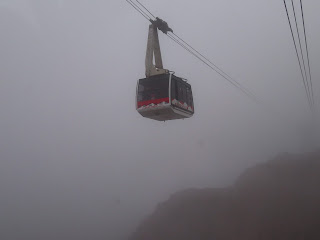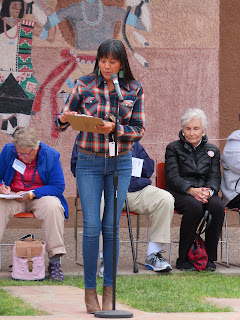Today, the balloons launched and we were able to watch
the balloons float right over the campers.
I love when they fly right over head!
Our friends, Kent & Jan were on a ride this
morning. So, we took pictures of all the Rainbow Ryder balloons.
Then we carpooled to the Sandia Peak Tramway. On our way, we saw the balloons descending.
And landing.
The Sandia Mountains are a large block of the Earth’s
crust. They were created by a gigantic slip or fault caused by pressures on the
earth’s crust, which occurred gradually over millions of years. They are
considered one of the greatest upthrusts or faults in the US and are comprised
of ancient granite. The granite was formed when magma deep beneath the earth’s
crust slowly cooled and solidified 1.4 billion years ago.
It is composed of mica, feldspar and quartz which make
the mountains appear pink at sunset. Hence the name, Sandia, is Spanish for
watermelon. Long ago, before the upthrust, when the surface of the earth was
changing and forming, this area was periodically invaded by seas. It is 1350
million years old granite and 250 million year old limestone and shale. There
are fossils from the old seabed in the limestone caps of the Sandias.
There are 4 climate life zones on the mountain. At the
base, also called Sonoran, it is 6,500 feet and you can find Chamisa, Pinon-Juniper
and Apache Plum. At tower 1, Transition, it is 7,200 feet and you will find
Ponderosa Pine. At tower 2, Candian, it is 8,500 feet with Aspen, Scrub Oak and
mixed Conifer. At the top, we are 10,000 feet high and called Hudsonian. There
are Douglas Fir, Spruce, Aspen and Limber Pine. Sandia Crest is the high point
on the Turquoise Trail, the magnificent summit of the Sandia Mountain has an
elevation of 10,678”. The view from the observation deck is awe inspiring on a
clear day.
The Aerial Tramway is a double reversible Jigback
Tramway built in 1946-66 at a cost of $2 million. It was manufactured by Bell
Engineering in Lucerne, Switzerland. It has a horizontal length of 2.7 miles
with a vertical rise of 3,819 feet and travels at an average speed of 13.6 mph.
As we rode to the top, the closer we got, the foggier
it got!
We did have a few spots where it cleared a bit.
Once we got to the top, we did see snow!
The Sandia Peak is in the Cibola National Forest.
Cibola is Indian for buffalo. The Cibola National Forest covers more than 1.6
million acres in New Mexico, with elevations ranging from 2,700 feet to over
11,300 feet.
After we got back down from the mountain peak, we
headed to the Indian Pueblo Cultural Center, it is a place where tradition
inspires. Founded in 1976 by the 19 Pueblos of New Mexico, the Indian Pueblo
Cultural Center is the preeminent place to discover Pueblo history, art and
culture.
The center was placed on sovereign land deeded to the
Pueblos by the Albuquerque Indian School, which was in operation through the
1980’s.
To celebrate their 40th anniversary in 2016
they opened their first permanent exhibit since their founding in 1976. The
exhibit is called “We Are of This Place: The Pueblo Story.”

Adorning the walls and courtyard of the Indian Pueblo Cultural Center are over twenty murals, each painted by a Pueblo artist.
The mural collection began in 1977 by Friends of the
Indian Pueblo Cultural Center. These murals honor many aspects of Pueblo life,
including dances, animals, seasons and agriculture.
There are a series of galleries and interactive
hands-on exhibits, which celebrate the Pueblo people’s ancient traditions,
legacy of resilience and living culture. I found the traditional native dancers
in the circle the most intriguing.
Since time immemorial, Pueblo people have celebrated
seasonal cycles through prayers, songs and dances. The dances honor the
Creator, connect us to the natural world, and deepen the connection to
ancestral ways of life.
We enjoyed lunch at the Pueblo Harvest Café on the
outdoor patio, with a roaring fire in the fireplace.
It is a full-service restaurant and bakery known for
extraordinary New Native American cuisine that incorporates traditional Pueblo
flavors into contemporary cooking. Some of us enjoyed an Indian Taco and others
had Salmon.
We went back to the Balloon Fiesta RV Park and started a few
preparations for our departure tomorrow. We gathered for our carpool to our
dinner at El Pinto. We dined on their twelve acre property in Albuquerque's
north valley. We were seated on one of their five patios, and enjoyed the
scenery with our friends.
Jack and Connie Thomas built El Pinto Restaurant in 1962. It
started as a one room restaurant with just a handful of tables and a small
kitchen. They built their home right by the restaurant so they could raise
their family and be close to their business. Slowly the restaurant expanded and
they added another room and an elegant patio where people could sit and enjoy
their meal during the warm weather.
Twin brothers Jim and John Thomas purchased the El Pinto
restaurant from their parents in 1994 and continue to use the same family
recipes created by their grandmother, Josephina Chavez-Griggs. To build on the
success of the restaurant and to meet the strong demand for their sauces, Jim
and John were motivated to produce them for retail distribution.
They started the El Pinto Foods' salsa division in 2000, so
people throughout the country could enjoy El Pinto Salsa and Green Chile Sauce
at home. The brothers' first production site consisted of a 35 gallon kettle
and a pump in the kitchen.
Today, El Pinto uses 120 tons of chiles a year, makes 4,000 cases a day and have the capacity to make 3-4 million jars a year in their 8,000 square foot salsa production facility which is attached to the El Pinto restaurant.
Today, El Pinto uses 120 tons of chiles a year, makes 4,000 cases a day and have the capacity to make 3-4 million jars a year in their 8,000 square foot salsa production facility which is attached to the El Pinto restaurant.





























No comments:
Post a Comment